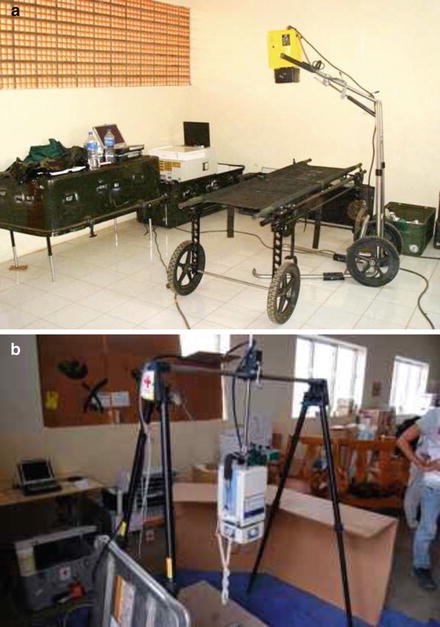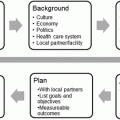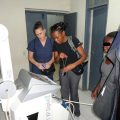Fig. 15.1
Field use of a portable ultrasound unit to evaluate a young woman with pelvic pain

Fig. 15.2
(a) Digital portable radiography unit (b) Digital radiology unit used by the Japanese Red Cross in Haiti after the 2010 earthquake. (Photo credit: David Townes)
To fully understand the role of radiology in the setting of natural disasters, it is necessary to examine the setting of such disasters, including the conditions on the ground and the populations in need of aid. It is also important to have an understanding of the disaster relief paradigm currently implemented by aid organizations across the globe. The role of radiology can then be explored within this contextual framework, and conclusions can be drawn about steps that might be taken to maximize the effectiveness of radiology in future catastrophes.
Defining the Mission
Aid efforts can generally be categorized as either humanitarian assistance or disaster relief. In order to adequately prepare for and execute a successful mission, it is crucial to first understand the integral components of disaster relief and humanitarian assistance. Disasters may result in humanitarian emergencies when the community’s status quo has been disrupted, often severely. Fundamental components of infrastructure such as potable water, electricity, food, and shelter are often devastated.
In addition, human resources such as healthcare providers, engineers, and law enforcement may have been lost to injury, death, or displacement. The population’s health is far from baseline, with numerous acute injuries and illnesses as a result of the disaster. The objective of the response is to both provide immediate life-saving medical care for those with acute, disaster-related injuries and illnesses as well as improve the health of a population through primary care services and public health initiatives. (Box 15.1). While the acute trauma patients are the most obvious victims and garner the majority of the media attention, there are generally two additional populations of patients to consider in planning disaster relief missions. One includes patients whose ailments are not related to the disaster but who are displaced from the medical system due to loss of infrastructure. This group includes patients with chronic illnesses such as diabetes and heart disease as well as patients who develop acute, non-disaster-related illnesses such as acute appendicitis, pneumonia, or motor vehicle trauma. The third population is often overlooked and underestimated but carries important value to the success of the mission. This group is at the heart of what is known as “medical diplomacy.” Local officials request personal medical assistance for themselves or on behalf of their family members for acute or chronic conditions that may not otherwise be triaged as urgently. While this goes against the classical teachings of medical delivery during crisis, it is crucial to embrace the fact that in many communities foreign medical team access to the general population resides in the hands of a small group of leaders. Establishing and maintaining a good rapport with this leadership may help facilitate the delivery of care to the populace [3].
Box 15.1 Patient Populations During Disaster Relief
Those acutely injured or ill as a result of the inciting event
Those with acute illnesses unrelated to the event (e.g., pneumonia, appendicitis, etc.)
Those with chronic illnesses who have lost access to care due to loss of infrastructure
“Special interest” patients
Coordination of Disaster Relief Efforts
Disaster relief and humanitarian assistance efforts demand significant amounts of human resources, organization, equipment, supplies, and other resources. Initial challenges include performing timely and accurate needs assessments with gap analyses, financing needed resources, mobilizing those resources, and coordinating deployment or distribution of those resources.
Within the USA, disaster response may fall under the jurisdiction of federal, regional, state, local, or tribal authorities depending on the scope and scale of the disaster. When a disaster occurs, the affected area may require assistance from multiple sources, including the state government, the federal government, or neighboring cities or states. At the federal level, the Federal Emergency Management Agency (FEMA) is part of the Department of Homeland Security (DHS) and serves as the lead in domestic disaster response. FEMA utilizes the National Incident Management System, which includes the Incident Command System (ICS). The ICS is used across all disciplines and at every level of government. According to the Emergency Management Institute [4], “The ICS is a management system designed to enable effective and efficient domestic incident management by integrating a combination of facilities, equipment, personnel, procedures and communications operating within a common organizational structure, designed to enable effective and efficient domestic incident management.” The ICS is used to coordinate and mobilize resources in a domestic disaster response. Among the components of the ICS are Disaster Medical Assistance Teams (DMAT), which are composed of medical professionals designated to provide medical care during a disaster as part of the National Disaster Medical System (NDMS).
Disaster response in the USA is generally well structured, financed, and coordinated, requiring little to no assistance from outside the country. The challenges faced by FEMA tend to be administrative and authoritative rather than resource related. In contrast, disaster response efforts in developing countries are complicated exponentially by lack of infrastructure, healthcare facilities, human resources, clean water, and other essential commodities. Such relief efforts generally require assistance from governmental organizations, nongovernmental organizations (NGOs), the United Nations (UN), and other international organizations.
In the United States, response to international disasters is coordinated by the Office of Foreign Disaster Assistance (OFDA) at the United States Agency for International Development (USAID).Disaster relief efforts in the developing world have had highly varying degrees of success over the years. In comparison to affluent nations such as the USA, disasters in resource-poor countries are more likely to result in significant destruction of vital components of local infrastructure, including buildings, power supply, roads, water and waste management facilities, and communications networks. There may be disruption of public health programs, destruction of healthcare facilities, and loss of key personnel including healthcare providers and other professionals. For the global community, the sheer scale of many of these disasters causes profound logistical challenges. Factors such as insufficient coordination, poorly defined roles, ambiguous leadership, inconsistent protocols, and misappropriated or inadequate resources frequently amplify these logistical challenges.
In 2005, a UN review of the global humanitarian system identified several inadequacies and generated several recommendations. These included strengthening the humanitarian coordination system; ensuring an emergency response fund capable of providing timely, adequate, and flexible funding; and adopting a “lead organization concept” by UN agencies and partners to cover critical gaps in providing protection and assistance to victims of conflict and natural disasters. In response, the UN Inter-Agency Standing Committee (IASC) established the “cluster system” for humanitarian relief efforts. There were initially nine clusters, including (1) Protection, (2) Camp Coordination and Management, (3) Water, Sanitation, and Hygiene, (4) Health, (5) Emergency Shelter, (6) Nutrition, (7) Emergency Telecommunications, (8) Logistics, and (9) Early Recovery. Two additional clusters, (10) Education and (11) Agriculture, were added later. In a disaster, each cluster is led by a designated agency charged with coordination and oversight of activities within that cluster.
Similar to the ICS, the cluster system is designed to provide structure and coordination to improve the effectiveness of disaster response. For example, there may be numerous organizations within one disaster response effort that focus on delivery of clinical care, ranging from large NGOs like Médecins Sans Frontières to small organizations with only a few members. It is important that these organizations coordinate not only with each other but also with organizations with a focus on public health initiatives such as vaccinations, water, sanitation, hygiene, and vector control. All organizations with a focus on health are encouraged to register with the Health Cluster and send a representative to Health Cluster meetings to receive up-to-date information, share experiences and knowledge, learn from each other, minimize duplication of efforts, and identify and respond to gaps in services.
Even with appropriate coordination, funding, and resources, many challenges remain. Depending on the individual situation, there may or may not be a functioning government as well as other groups with various missions and political agendas. Some of these groups may be corrupt or have agendas based on culture, religion, or ethnicity. There may also be differing missions among the various relief organizations involved in a single relief effort, often reflecting the agendas of their constituencies. Such differences can lead to conflicts that delay recovery efforts and harm no one more than the victims these organizations are supposed to be helping (Box 15.2).
Box 15.2 Overview of the Cluster System
UN Inter–Agency Standing Committee (IASC) established the “cluster system” for humanitarian relief efforts.
Clusters:
(1)
Protection
(2)
Camp Coordination and Management
(3)
Water, Sanitation, and Hygiene
(4)
Health
(5)
Emergency Shelter
(6)
Nutrition
(7)
Emergency Telecommunications
(8)
Logistics
(9)
Early Recovery
(10)
Education
(11)
Agriculture
Effective disaster response begins with a timely and accurate assessment of the situation followed by a response that is well coordinated, adequately funded, appropriately resourced, and culturally appropriate. While each disaster is different, lessons from each relief mission should be reviewed and utilized to improve the response to subsequent disasters.
Stay updated, free articles. Join our Telegram channel

Full access? Get Clinical Tree






